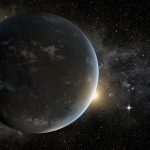Key Takeaways:
- Astronomers have discovered 70 free-floating planets (FFPs) without a parent star in the Milky Way, doubling the known sample of rogue planets.
- This groundbreaking discovery was led by Nuria Miret-Roig and a team of researchers from various institutions, and published in Nature Astronomy.
- FFPs, also known as “Rogue Planets,” have eluded direct observation due to their faintness, but recent advancements in technology and data analysis techniques have made their detection possible.
- The newfound FFPs are comparable in mass to Jupiter and are located in the Scorpius and Ophiuchus constellations, the closest star-forming region to our Solar System.
- This discovery challenges previous assumptions about the prevalence of rogue planets in our galaxy and has significant implications for our understanding of planet formation and potential habitats for life.
The field of extrasolar planet studies has undergone a remarkable transformation in recent years. Initially, astronomers had only a handful of exoplanets to investigate, but today, they have 4,884 confirmed exoplanets and another 8,288 awaiting confirmation.
Amidst this proliferation of exoplanetary knowledge, a particularly astounding discovery has emerged. Our galaxy, the Milky Way, is teeming with exoplanets that lack a parent star. These “Rogue Planets” or free-floating planets (FFPs) have long been speculated about, and recent research has unearthed the largest sample of 70 such starless planets to date, nearly doubling the available pool for scientific scrutiny.
This groundbreaking research was spearheaded by Nuria Miret-Roig, a postdoctoral researcher affiliated with the Laboratoire d’Astrophysique de Bordeaux and the University of Vienna. Collaborating with fellow researchers from various institutions, including the National Institutes of Natural Sciences in Kyoto, the Centre National de la Recherche Scientifique in France, and the Centro de Astrobiología and Departamento de Inteligencia Artificial in Spain, Miret-Roig’s team detailed their findings in a recent publication in Nature Astronomy.
Rogue planets, often referred to as FFPs, have been the subject of speculation for many years. Numerical simulations have suggested their potential prevalence, even to the point of possibly outnumbering the stars within the Milky Way. The mechanisms responsible for these planets going rogue remain enigmatic, with various theories positing their formation in interstellar space, gravitational interactions with passing stars, or being expelled by supernovae or the death of their parent stars. Previous observations had identified FFPs in young stellar clusters and the Galactic Field, but these samples were often small or exhibited diversity in age and origin.

The challenge in studying FFPs arises from their difficulty to be imaged in visible light, much like the challenge of identifying exoplanets orbiting significantly brighter stars. To overcome this, astronomers needed access to exceptionally sensitive telescopes and instruments, a daunting task akin to finding a needle in a haystack when the needle happens to be the least shiny object.
Nuria Miret-Roig’s team tackled this challenge by combining the proper motions of celestial objects with multi-wavelength photometry obtained over two decades from observatories worldwide. These included the Isaac Newton Group on the island of La Palma, the Canada-France-Hawaii Telescope in Manua Kea, Hawaii, and various telescopes in the Atacama Desert in northern Chile, such as the ESO’s Very Large Telescope and Visible and Infrared Survey Telescope for Astronomy. In addition, astrometric observations from the European Space Agency’s Gaia Observatory were instrumental in this research.
Younger rogue planets, still warm from their formation, allowed for direct detection by sensitive telescopes and cameras, necessitating deep wide-field observations by infrared and optical telescopes. This extensive effort provided the team with data on 70-170 new FFPs, comparable in mass to Jupiter, located in the Scorpius and Ophiuchus constellations, which are the nearest star-forming regions to our Solar System.
Nuria Miret-Roig expressed her excitement about this discovery, emphasizing that it marks the largest single-sample of FFPs ever found. The inclusion of these FFPs in the dataset is poised to significantly advance our understanding of their nature and origin, as well as the mechanisms behind their existence.
This discovery also paves the way for the future, as it bolsters astronomers’ theories about the prevalence of FFPs in our galaxy. If the fraction of FFPs observed in the Upper Scorpius region mirrors that of other star-forming regions, then there could be billions of Jupiter-mass rogue planets traversing the Milky Way, as well as an even greater number of Earth-mass planets, some of which have already been observed.
To delve deeper into the mysteries of these rogue planets, astronomers are eagerly awaiting the completion of the Extremely Large Telescope (ELT) in the Atacama Desert, slated for a 2027 debut. Additionally, NASA’s Nancy Grace Roman Space Telescope, scheduled for launch the same year, will conduct exoplanet surveys, potentially including smaller free-floating planets similar in size to Mars.
Rogue planets could prove to be excellent subjects for studying planetary atmospheres and the formation of circumplanetary discs, shedding light on these intricate processes. Moreover, this discovery carries implications for models of planet formation and evolution, offering insights into the origin of habitable planets and life.
One particularly fascinating possibility arising from this research is that rogue planets might host life. Conceivably, life could exist in subterranean pockets where the slow decay of radioactive elements or convection provides the necessary heat. There is also the potential that rogue planets harbor moons with thick atmospheres and water on their surfaces, raising the tantalizing prospect of life. As we prepare to study hundreds or thousands of these FFPs in the coming years, we are on the cusp of unraveling these captivating possibilities and expanding our understanding of the cosmos.


